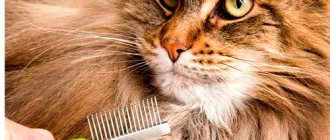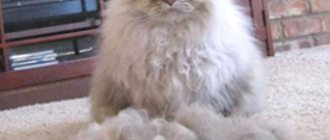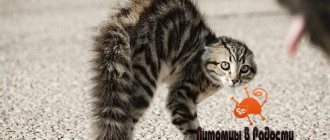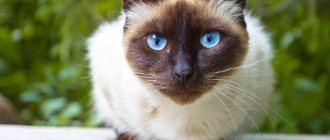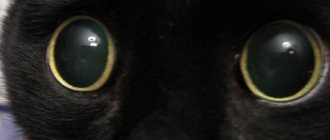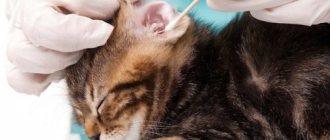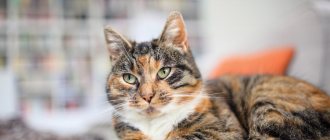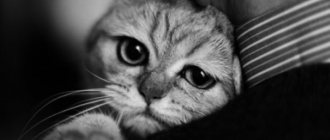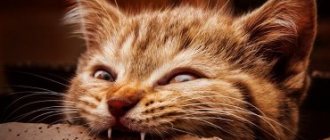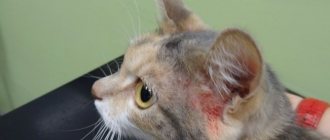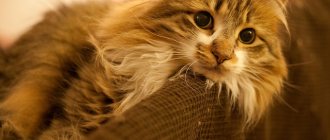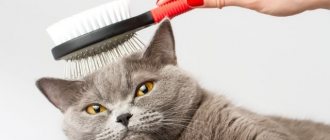All cats shed periodically. For them, this is a natural process of renewing their coat. In such cases there is no cause for concern. But sometimes the hair falls out a lot, which requires taking certain measures.
- Shedding in British breed cats
- Why does a British cat grow hair out of season?
- Prevention
- British cat sheds a lot: what to do
Types of molts and their causes
The first shedding in Scottish cats begins at the age of 6 months and under normal conditions ends by 8 months.
The frequency of subsequent molts depends on the following factors:
- air temperature and daylight hours;
- nutrition - sometimes a change in diet and an imbalance of beneficial elements affects the quality of the coat and the number of molts;
- general health and veterinary support;
- hormonal background;
- genetics.
Seasonal
Under normal conditions, the shedding cycle in Scottish cats involves renewal of fur 2 times a year, which occurs during the change of seasons (from warm to cold and vice versa). At the same time, in the natural environment, the body of a lop-eared pet must respond to a decrease (increase) in the duration of daylight hours and temperature conditions. However, during seasonal molting, the Scottish coat is renewed in different ways. In autumn, the undercoat becomes denser to protect the skin from exposure to cold air, but in spring, on the contrary, its density decreases, and the coat itself becomes thicker and longer.
Constant
This mode of coat change is sometimes called “apartment”. This shedding is typical for all Scottish Fold cats that live in apartments and are never or extremely rarely outdoors. Their body loses touch with the natural seasons, for which all its natural protective algorithms are designed. In recent decades, this phenomenon has occurred quite often. Constant shedding negatively affects the immune system, general health, depresses the animal and often causes diseases that are not typical for ornamental breeds.
Reasons for regular shedding in Scottish cats include:
- artificial lighting, which increases the length of daylight hours for the animal;
- uniform temperature regime without daily or seasonal changes;
- dry air is especially dangerous for cat fur during the heating season;
- cats' habit of being near radiators or other heating devices.
The only thing you can do when your Scottish sheds a lot is to organize a change in temperature and living conditions for the cat. To do this, give the pet a place on the balcony, take it outside more often, turn off the lights at night, humidify the air and regularly ventilate the premises. As soon as the body receives a signal about the change of season, the process of changing coat is normalized.
Sudden
Sudden hair loss in a cat most often indicates the development of negative processes in the body. They can be associated both with the state of physical health and with the presence of psychological problems. Only a professional veterinarian can figure out the reasons, and independent actions only aggravate the negative trend, and then the molting will become permanent.
During pregnancy and lactation
Very often, pregnancy and the postpartum period become a trigger for the onset of molting. The reason why a Scottish cat has a lot of hair is that the body devotes all its energy to the health of the kittens, and leaves its own needs “for later.” Normally, hair loss ends after kittens are weaned from the cat. If the process does not stop, you need to contact a veterinarian.
For diseases
If a cat sheds heavily, the owner should pay attention to its health. Hair loss is directly related to the physical and psychological condition, and it can only be stopped after neutralizing the underlying disease
Also, the coat of a Scot changes in the following cases:
- castrated cats can experience changes in hormonal levels, replacing the energy of sexual desire with unexpected molting;
- This also applies to unsterilized animals - in cats that do not bear offspring, the body can behave unpredictably.
- a number of diseases, from epiphora (lacrimation) to urolithiasis or cardiac pathologies that can cause sudden molting;
- Stress is the most common reason for shedding fur.
Scottish kittens shed a lot during their first change of residence. This is how the pet’s body reacts to adaptation to a new place.
Constant
Shedding, during which a British cat loses fur greatly over a long period of time (more than six months), indicates the development of pathological processes in the body. Sometimes it is associated with physical health, but much more often it indicates severe stress and other similar factors.
Important! The first thing you should pay attention to during constant shedding is the diet and living conditions of a British cat. These are the most common causes that cause excessive hair loss.
British cat sheds a lot: what to do
To figure out how to help your pet, you first need to understand why a British cat's hair is coming out.
Initially, you can start bathing the animal with a special medicated shampoo and add essential fatty acids to its diet in recommended doses. If you have changed food, you should return to the products of the previous brand. But if the cat is not pregnant or lactating, has not been stressed, and no changes have been made to its diet, it is worth visiting a veterinarian. After examination and obtaining laboratory test results, a specialist will be able to diagnose the disease that has caused severe hair loss.
If pathological changes are detected in the animal’s body, treatment appropriate to the situation will be prescribed. If a cat is diagnosed with ringworm caused by microsporia or trichophytosis, complex therapy will be required.
It must include:
- cutting hair around the affected area;
- antifungal agents for topical use (creams, ointments, shampoos);
- oral or injectable antifungal medications (only given to adult cats);
- disinfection of all objects with which the animal has been in contact.
If hormonal disorders that are not related to physiological processes are detected, correction with special medications will be required. In each case they are selected individually.
If your British cat is shedding...
Continuing the conversation about how to care for the fur of British cats, I would like to talk in more detail about when British cats begin to shed and how long it lasts. Many owners of British cats do not know that British cats shed in spring and autumn, and begin to panic when the cat suddenly begins to shed hair.
But, if the animal constantly lives in an apartment where the air temperature is constant, you take good care of it, give it vitamins, bathe it regularly, then the molting process itself may go unnoticed.
Often, British cats can suddenly begin to shed after giving birth, and there are also cases of unscheduled shedding after severe stress, or as a result of poor nutrition. Every owner of a British cat should learn the golden rule - the condition of the coat is the first indicator of the health of the animal.
The duration of seasonal shedding in British cats depends on the room temperature and nutrition. On average, British cats shed for about one month.
As mentioned earlier, the appearance and quality of fur in British cats is the first indicator of a cat’s health. Hair loss in Britons may also be due to a weakened immune system. Here are some of the most common reasons.
The best Reminder for puppy owners
Due to poor nutrition and lack of vitamins and microelements, cats can develop dermatitis, leading to hair loss. Also, a cat may begin to shed due to allergic reactions, for example to dry food. Any kind of hormonal changes in the cat’s body, due to the absence or disruption of mating phases, also lead to hair loss. This also includes the use of hormonal drugs.
Also, one of the reasons for hair loss in cats may be the presence of fungus. After infection with microorganisms such as microsporia and trichophytosis (ringworm), hair falls out only in certain places. To establish a final diagnosis, you should contact your veterinarian to take swabs and check the infected areas for the presence of fungi under a special lamp.
Basic Rules
It is possible to alleviate the suffering when a British cat sheds heavily, but it is not always possible to observe all the necessary points. To avoid allergies among family and visitors to your home, regularly ventilate the room and clean it.
Special shampoos will also help you, somewhat reducing hair loss and making the process when the animal sheds less noticeable and painful.
However, there are times when the best solution would be to seek advice and help from a veterinarian. For example, if you notice hair loss only in certain places on the body of a British cat, and the hair itself falls out unevenly in clumps, immediate treatment is necessary. Often these symptoms are caused by infections of microsporia and trichophytosis, or ringworm. Such diseases are dangerous both for the pet itself and for the owners.
Why does a British cat shed a lot?
Britons shed twice a year. Typically in spring and autumn. This is the first thing animal owners should know about their pet. And if the cat suddenly begins to lose tufts of its fur during these periods, then there is no reason to worry.
Sometimes the shedding process goes completely unnoticed if you take special care of its fur. Such care may include combing, bathing with special shampoos, as well as properly selected food.
But sometimes the Briton begins to actively shed “at the wrong time.” What can cause such a pathology? Unplanned shedding may begin after kittens are born. The cause of the active loss of six may well be the stress experienced. Poor nutrition also leads to unplanned shedding because the skin and hair follicles do not receive the necessary vitamins and minerals in the right quantities. The litmus test for your pet’s health can be precisely the condition of its luxurious fur coat.
The duration of seasonal molting, as a rule, is no longer than a month. The duration largely depends on the temperature of the room where the animal spends most of its time, as well as nutrition. But with a protracted process, there is reason to be concerned about the health of your pet, since prolonged molting can cause the animal to become ill.
Active hair loss can be caused by dermatitis. There are several reasons why the disease develops. This:
- Unbalanced diet.
- Lack of vitamins and microelements the cat needs.
- Allergies triggered, for example, by dry food.
- Changes at the hormonal level associated with the absence of mating or disruption of its phases.
- Taking hormonal drugs.
Intense and prolonged shedding in British or Scottish cats is a reason to visit the veterinarian's office. The animal will be scheduled for testing. It is likely that the cause of molting will be determined after a thorough examination of the cat by a doctor. The true cause of increased hair loss may lie in serious diseases such as ringworm or fungus.
In addition to the above reasons, the British dog can actively shed:
- due to constant stress;
- worm infections;
- existing problems with the gastrointestinal tract;
- for existing pancreatic problems;
- for liver diseases.
What to do: how to reduce the amount of hair loss?
If there are signs of unhealthy shedding, there is no need to self-medicate; you need to seek help from specialists.
Sometimes cutting the animal helps solve the problem.
If a Scots sheds during the season, during this period the following rules for caring for your pet should be followed:
- brush the fur daily with a brush and massage movements;
- bathe the cat using a special shampoo;
- trim the animal to reduce the amount of hair falling out;
- ventilate your home, this helps reduce the concentration of cat hair in the air;
- provide your pet with a balanced diet enriched with vitamins;
- eliminate all possible stress factors.
By adhering to simple rules, you can significantly reduce the amount of wool throughout the apartment and on upholstered furniture, and prevent the development of an allergic reaction in the owner. You can also prevent unwanted diseases in your British cat, because when licking the cat’s fur, the cat swallows hairs that form a hairball in the stomach, causing indigestion and other internal problems.
Do British breed cats shed?
Almost all cats shed, including British cats. Shedding is the natural replacement of dead hair with new hair. It also depends on various reasons. Here are some of them.
- Animal nutrition. Britons can shed if the food is not chosen correctly. You need to use common sense and buy food for British cats, or for shorthair cats, in accordance with their age group (for young cats, for cats under 7 years old, for cats over 7 years old).
- Temperature conditions. If the apartment or house is hot, the temperature stays at 24-25 degrees. C, then the cat will almost certainly shed in the winter.
- Season. For example, my cat sheds a lot in winter and spring during the heating season (he lives without walking), in summer and autumn - significantly less. If a cat has a walk, he will not shed in the cold season; most likely, shedding will begin in spring and summer.
- From the individuality of the animal. Some cats shed more, others less. It is a fact. My son’s British cat hardly sheds, but mine sheds quite a lot (also British).
To reduce shedding in a British cat, in addition to the reasons listed above, you need to take care of the animal’s fur - comb the cat regularly (2-3 times a week), wipe its fur with a damp cloth.
Cats are perhaps the most beloved of pets. Any changes in a pet’s body, including molting, cause owners not only fear, but sometimes even panic. Especially when it comes to the British Shorthair breed.
Description of the Golden British Chinchilla
The basic characteristics of chinchilla cats correspond to the standards of the British Shorthair cat. The difference between these animals is the length and thickness of the fur; representatives of the first breed.
Appearance
British chinchillas are distinguished by a large, wide chest, strong hips and a straight back. In general, their physique is squat, their muscles are well developed. The weight of cats reaches 5-8 kg, cats 3-4 kg.
The breed standard requires compliance with the following appearance features:
- A rounded head with a wide forehead smoothly transitions into a rounded muzzle with round cheeks.
- The nose is straight, short, with a pinkish nose.
- Small ears, rounded at the ends, set wide apart.
- The neck is muscular and short.
- The round eyes are set shallowly. The ideal eye color for chinchillas is emerald, but yellow and blue shades are acceptable.
- The paws are proportional, muscular, but rather short, and therefore give the impression of being stocky.
- The tail is thick and not too long and ends with a rounded tip.
- The coat is short, thick, and the undercoat is well developed.
There are three main color options for chinchilla cats:
- Silver. Recognized as the most common color of the breed. The belly and chest of cats are almost always white, dark areas are localized on the back, sides and tail.
- Gold. The coat of such cats has a delicate peach tint. These pets are also called the British red chinchilla.
- Shaded silver. Compared to the usual silver color, the animal's fur looks darker. In this case, most of the length of the hairs is shaded, and the undercoat remains white.
This is interesting. Among British chinchillas there are color-point individuals. The colors on the ears, paws and tail of these animals are more “Siamese”, and the color of the eyes is blue.
Character
Golden Britons have a calm disposition. These pets are inactive and do not need constant games and physical activity.
Like all representatives of the cat family, the British have an independent disposition and, at the same time, are attached to their owner. Although chinchillas are affectionate, trusting cats and strive to spend as much time as possible near people, they need a separate place to rest.
Due to the lack of aggression on the part of chinchillas, they are often kept in families with children. These furry creatures almost never hiss and, moreover, do not extend their claws. If a golden cat feels irritated, she will simply move away from the place in which she feels discomfort. Golden chinchillas also get along well with other pets, including dogs or other cats.
For your information. Britons are one of the easiest breeds to train. From the first days of being in the house, this cat adopts the rules of the family in which it happens to live. The pet easily gets accustomed to the tray and scratching post.
Health
Health problems can also cause shedding. Changes in hormonal levels can lead to hair loss. Cats shed hair after giving birth, and this is normal. But changes can also be caused by the proximity of an animal of a different sex. Even if the prospective partner lives in the next doorway, the cat can smell him. Inability to satisfy the sexual instinct or, conversely, exhaustion from frequent mating or childbirth can cause molting. Veterinarians recommend sterilizing animals not intended for breeding. This avoids hormonal surges and reduces the likelihood of tumor diseases.
Shedding can also be caused by various diseases. Severe hair loss can be an alarming symptom along with an unpleasant odor from the mouth, coughing, scratching, lethargy, etc. A veterinarian should figure out what the pet is sick with and prescribe treatment. Shedding caused by the disease will only go away after the animal has recovered.
How to protect your animal from uncontrolled shedding?
To avoid uncontrolled molting, you should follow a number of rules:
- the temperature in the room should be relatively constant; sudden changes in temperature should not be allowed; a pet, like a person, does not adapt well to external and internal changes;
- avoiding stressful situations that are dangerous to the cat’s mental and physical health;
- Maintain the coat by regularly bathing with cat shampoo, and use anti-matting lotions and sprays;
- An important aspect is combing, it is worth choosing the right comb, it should have frequent teeth. The choice is between metal (possible electrification of wool) and wooden combs (can catch hairs when combing), there are also plastic ones (roll wool);
- A balanced diet is what determines the internal and external health of your pet.
Best Savannah cat (28 photos)
Watch a video on how to deal with shedding in cats.
Care and feeding
Your cat sheds a lot
What to do if she is healthy and calm, but her fur continues to fall off? Pay attention to the quality of shampoos and conditioners for fur coat care. Cheap, low-quality cosmetics can cause shedding
In addition, shampoos must be used according to the instructions and the concentrate must be diluted correctly. Brushing not only helps to get rid of lost hair, but also improves blood circulation and nutrition of the hairs.
The cat sheds a lot. What to do? Finally, one of the most common causes of hair loss is poor diet. Cheap dry food cannot provide your furry pet with everything it needs. Choose quality products from well-known manufacturers. Natural nutrition should be balanced and the menu varied. It is wrong to feed your cat food from your table or chicken breast alone. She needs lean meat, fish, offal, eggs, raw vegetables, fruits, and herbs.
In conclusion, a few tips:
- comb your pet, avoiding combs with sharp teeth;
- wash your cat only with high-quality shampoo;
- use vitamin supplements during natural feeding;
- Buy special conditioners for cat fur.
A healthy cat living outdoors sheds twice a year, in spring and autumn. By summer, cats actively shed their fur in preparation for the hot season. In autumn, on the contrary, they increase their fur coat in anticipation of the winter cold. Animals living in an apartment are also subject to shedding, but often this process is delayed or becomes uncontrollable when the cat sheds heavily almost all year round.
If your pet is an apartment dweller, without access to “free range”, then most likely he is prone to increased hair loss. In winter, when the fur coat should grow, the opposite process is observed. In apartments with central heating, dry and warm air dictates the animal to shed excess fur for a more comfortable feeling. A hot battery replaces thick winter fur for our pets, and artificial lighting and, as a result, longer daylight hours complete the picture.
To avoid hair loss from overheating, if possible, keep the animal away from radiators, install air humidifiers, and ventilate the apartment more often. If you have a balcony or loggia, set up a “winter” house for your cat on the balcony, install scratching posts, multi-level shelves and ladders there so that the animal is interested in going out into the fresh air.
Gastrointestinal disease or hormonal imbalance
Some breeds with a thick undercoat, in particular, British, Siberian, Maine Coons, shed all year round, so if there are no other visible problems with the coat, then there is no reason to worry.
Animals that spend the winter months in an apartment and move to the country in the summer tend, on the contrary, to increased hair growth in the summer months, when they have access to walking, and therefore upon returning to a city apartment are subject to more intense molting.
Considering seasonal factors and the specifics of keeping pets, it is very important not to mistake skin diseases for normal shedding. Such diseases include allergic reactions to food or medications, fungal diseases
Hair loss can be associated with gastrointestinal and hormonal problems and may be accompanied by itching, redness, and the formation of patchy bald patches.
Do not self-medicate under any circumstances; take the animal to the veterinarian.
The clinic will do the necessary tests (scraping at the site of alopecia, blood test), conduct diagnostics and prescribe treatment. It is possible that excessive hair loss is due to a lack of vitamins, in which case the doctor will recommend a complex that is suitable for your pet.
Most often, cats with focal lesions are prescribed simple and effective vitamins, for example, brewer's yeast. If all other vital signs of the animal are normal, then within two weeks you will notice a significant improvement in the condition of the hair coat.
Shedding may be associated with food changes
The cat sheds heavily due to problems with the gastrointestinal tract or food-related allergies. Excluding certain foods from the diet, as well as adding vegetable fats, will help restore your pet’s coat and return it to its usual shine and shine.
Causes of shedding
One of the reasons for severe hair loss can be childbirth. After all, the offspring takes a lot of nutrients, and if you don’t feed the mother with vitamins in time, then a sudden change in coat is guaranteed.
Stress can also be a reason for shedding, which means you need to love and cherish your cat. The main indicator of a cat's health is its shiny, silky coat.
Another reason may be skin diseases. Dermatitis is a consequence of improper, monotonous nutrition, which can be avoided by using a complete and varied diet.
Following the recommendations of experts, in order to avoid problems with shedding, you need to pamper your pet with a raw egg once a week to fill the body with vitamins
You also need to pay attention to the microclimate in the house; dry air also stimulates hair loss
Changes in hormonal levels also provoke molting. You need to carefully monitor the health of your pet, and if there is prolonged hair loss, contact a veterinarian to receive qualified and timely help.
Some diseases can be dangerous for adults and, especially, for children who love cats very much.
Why is wool dangerous for humans?
Cat hair on carpets, furniture, and clothing can cause serious health problems for the owner of the animal. The cause is the animal's saliva, which, when it gets on the fur (and, accordingly, on a person) can provoke allergy attacks.
Allergic reaction
Manifests itself in the form of nasal congestion and excessive lacrimation. Antihistamines can provide first aid.
It turns out that wool can be dangerous not only for humans. The thing is that if it gets into the stomach of an animal, it can cause problems with the digestive organs. Therefore, you need to contact a veterinary pharmacy for medications that help cleanse the intestines.
How to deal with hair when shedding in British cats?
Intensive home ventilation helps reduce the concentration of cat hair in the air. Regular use of shampoos that are designed to care for cats and the use of a special comb will help to survive periods of shedding. Regular and constant brushing will ensure thorough hair removal.
The best Why is a bull terrier dangerous?
Still, you need to remember that shedding is a temporary phenomenon, your love and timely care will help the British cat cope with these troubles, and your pet will bring joy to you and your family.
https://youtube.com/watch?v=1dU9WEDWPc8
How to care for a British cat correctly?
Many families have long been imbued with a love for British cats. The main distinguishing features of these animals are a calm disposition, cleanliness, curiosity, and sociability. They fully justify their name...Read more →
How to care for British kittens?
Having just bought a British kitten, it is important for the owner to know how to care for a British kitten. The baby, separated from his mother and the rest of the kittens and found in a new home,...Read more →
What is the weight of a British kitten by month?
The birth of kittens is a joyful event in the house. In the first two months, the mother cat takes care of the newborns and their weight and development mainly...Read more →
Signs of diseases
Hair loss may only be a symptom of a more serious disease. With active molting, you need to pay attention to other manifestations. Along with shedding, the following symptoms may occur that indicate illness:
- loss of interest in games, walks, if this has not previously been observed;
- refusal to eat, lack of appetite for more than a day;
- restless behavior, aggression;
- rapid breathing, rapid pulse;
- high body temperature;
- sneezing, coughing;
- vomiting and diarrhea;
- presence of blood in excrement;
- profuse tearing and salivation;
- strong and constant thirst;
- skin redness;
- frequent scratching;
- urinary incontinence;
- wheezing when breathing.
Making a diagnosis on your own will not be so easy. In addition, self-medication can be dangerous, so if such symptoms occur, you need to show your cat to a doctor. If none of the above is observed, only a lot of fur is coming out, special care, some changes in diet and environmental conditions will help.
Prevention
To reduce the likelihood of severe shedding, owners need to:
- feed the animal a balanced medicinal food, to which he is definitely not allergic;
- give vitamin complexes specially selected for representatives of this breed in accordance with age characteristics;
- avoid stress, and when moving or having a baby, try to pay more attention to the cat than usual in order to make it easier to adapt to new life circumstances;
- plan mating solely on the basis of the biological cycles of the animal;
- comb regularly;
- bathe the cat no more than once every 3 months, since short-haired animals do not need frequent hygiene procedures;
- maintain constant temperature and humidity in the house.
Reducing stress levels
The most common cause of stress for a British cat is noisy company in the house and lack of privacy. The breed prefers solitude rather than constant communication.
Failure to comply with this condition leads to increased emotional stress, which can result in aggression or lead to the onset of prolonged molting.
Once the source of the irritation is eliminated, your Briton will be at peace and will return to his normal coat changing routine.
How long does seasonal molting last?
If you are scared by your kitten's long first molt, don't worry. This is due to complex processes of physiological maturation. Shedding in cats that can be called adults goes back to normal. On average it lasts a couple of months a year. Once in the spring, and again at the end of autumn. There may be minor time shifts in the schedule.
Usually short-haired pets fit into the schedule and timing of shedding. It’s more difficult with the fluffier ones. Persians or Maine Coons, after shedding their guard hairs, take a long time to get rid of the undercoat. They definitely won't be able to do it without your help. If you don't help them with their struggle, the consequences can be serious. From local tangles to completely matted fur.
Sometimes shedding in cats occurs unplanned or does not stop for a long time.
Owners' opinion
Domestic British cats. Character, reviews:
- For many people, the waywardness of the British does not seem to be a problem. You can get used to it. If you are patient, show love and care, the cat will reciprocate;
- Many people like the ease of care associated with natural cleanliness. Still, when your corners, sofas and slippers remain intact, it’s nice.
So, according to most owners, this cat is a gift from fate. She is kind, calm, and adequate from a very early age. Fortunately, the character of any purebred British cat is quite acceptable even for a family with a small child.
What if it is still a disease?
What to do if your cat sheds a lot in the spring? Some owners mistake skin diseases for traditional shedding. But it is caused by an allergy either to food, medications, or fungi.
You also need to seriously think about the situation if hair loss is associated with diseases of the gastrointestinal tract. Or even with hormonal imbalance. Often this externally looks like redness, itching, and the appearance of bald patches on the cat’s body.
Do not try to treat your pet yourself. Do not read treatment methods on the Internet. You can only do harm. Take the animal to the veterinarian. The veterinary clinic will do all the necessary tests, determine the diagnosis and prescribe appropriate treatment.
Does a British cat shed a lot? What to do? There are probably not enough vitamins in his diet. Then the doctor will select the ones your cat needs.
Usually, those who have clearly visible focal lesions are prescribed fairly simple but well-functioning vitamins. For example, brewer's yeast. If all other indicators are normal for the cat, then only two weeks will pass and you will see how much her hair has improved.
Sudden
The cause of sudden shedding of a British cat is most often diseases caused by a sudden change in diet, deterioration of living conditions and other factors.
A British cat's hair sheds a lot in the initial stages of the development of skin diseases. Most often this manifests itself at the local level and is expressed by focal lesions.
Sudden molting is always a consequence of some negative phenomena of a physical or psychological nature. As soon as the irritating factor is eliminated, the shedding of fur will immediately stop. Otherwise, the process moves to the next phase.
This is interesting: Nutrition of a 2 month old British kitten
